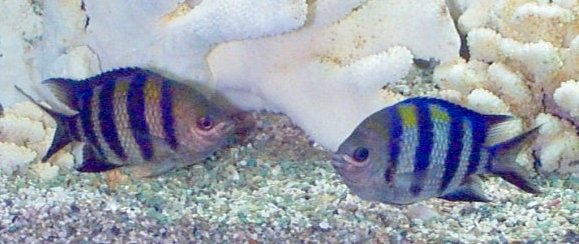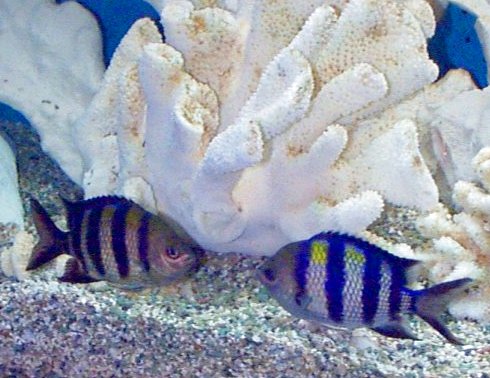AKA Five Banded Damselfish
Abudefduf saxatilis [Linneaus)
 |
Name: Sergeant - Major Fish |
Scientific name: Abudefduf saxatilis |
Range: Atlantic Ocean |
Habitat: Lives near coral reefs or rock jetties |
Status: Overall there is no large threat to the species. The global trend of coral reef destruction could result in endangerment. |
Diet in the wild: Omnivorous - plankton found in coral reaf or nearby rocks |
Diet in the zoo: Because they are damsel fish they will eat about anything. The zoo feeds them brine shrimp that they buy frozen and other types of prepared frozen plates. |
Location in the zoo: James R. Record Aquarium |
Physical description: |
General information: |
Special anatomical, physiological or behavioral adaptations: During the months of April - August mating occurs and territories are established for reproduction. This is when the male is extremely territorial . Also, during mating the male of the species becomes deep blue (note the blue fish in the photo below). Other than waiting for mating season it is really hard to determine males from females and vice versa. Many damsel fish change sex over their lifetimes, beginning as male, and then as they grow, become female. |
Comments about the Sergeant Major Fish of the Fort Worth Zoo: The Fort Worth Zoo agreed that these fish are beautiful and are easy to take care of. They basically will eat anything. They are also great pets! |
Personal Observations: |
Sources and Links |
Page author: |
![]()
WhoZoo
Home
WhoZoo
Gallery
WhoZoo
Animal Index
Fish
at the Fort Worth Zoo

 Sergeant
Major - Army Insignia
Sergeant
Major - Army Insignia

